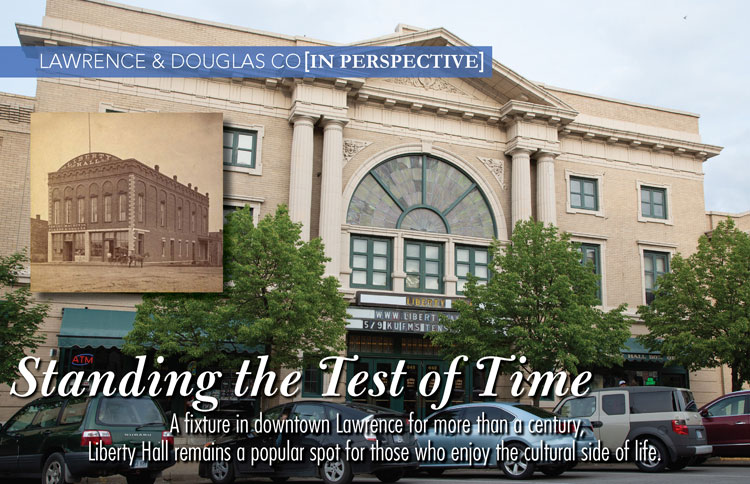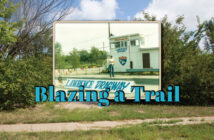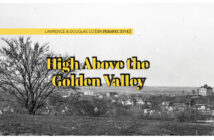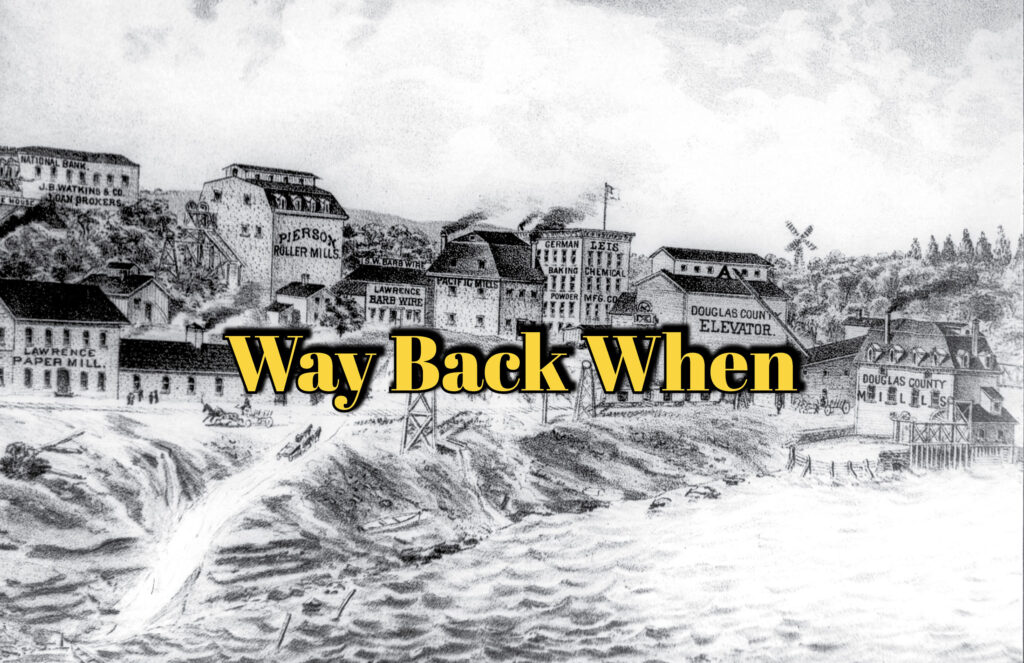| story by | |
| photos by | Steven Hertzog |
and courtesy of the Kansas State Historical Society, kansasmemory.org
A fixture in downtown Lawrence for more than a century, Liberty Hall remains a popular spot for those who enjoy the cultural side of life.

Liberty Hall – past and present
The words “freedom” and “liberty” have a long association with 644 Massachusetts St., the location of Liberty Hall. Originally the site of the first Free State newspaper in Lawrence, it now serves as a location for concerts, theatrical performances, two movie theaters showing classic, foreign and independent films, and a wedding and special events venue. The structure housing Liberty Hall has been a fixture in downtown for more than 100 years, and events at that site have contributed to Lawrence’s cultural milieu for even longer.
The Kansas Herald of Freedom, first published on Jan. 6, 1855, was the first Lawrence newspaper to champion the Free State cause. George Washington Brown was the publisher, coming to Kansas Territory from Conneautville, Pennsylvania. With support from the Massachusetts Emigrant Aid Company (later renamed the New England Emigrant Aid Company), the newspaper had a large circulation, and Brown vigorously promoted the settlement of Free-Staters. However, the building housing the Herald of Freedom was destroyed during the Sack of Lawrence, in 1856. The building was rebuilt to house other businesses, but that structure was destroyed during Quantrill’s raid, on August 21, 1863.
In 1870, the building was christened Liberty Hall, a name suggested by Rev. E.D. Bentley because Abraham Lincoln had once called Lawrence the “cradle of liberty.” In 1882, J. D. Bowersock purchased and renovated Liberty Hall, adding a second-floor gathering space. He named it the Bowersock Opera House, and it became a popular spot for community events including festivals, dances and political debates.
Justin DeWitt Bowersock was born in New Alexander, Columbiana County, Ohio, on Sept. 19, 1842. After a few years as a grain merchant in Iowa City, Iowa, he moved to Kansas in 1887. He was involved in banking and manufacturing. Though he did not build it, he purchased the Bowersock Dam on the Kansas River to provide electrical power to businesses and manufacturers. In 1878, he founded Douglas County Bank, now the Lawrence National Bank. He established the Kansas Water Power Co., the Griffin Ice Co. and the Lawrence Iron Works. Bowersock was also involved in local politics, serving two terms as mayor from 1881 through 1885. In 1886, he was elected to serve in the Kansas House of Representatives and moved to the State Senate in 1895. He served in the U.S. House of Representatives from 1899 to 1907. In his first election as representative to Congress from the Second District, he received a majority vote of 2,000; at his second election, 2,500; at his third, 4,000; and fourth, 6,000.
Charles Gleed, a prominent Kansas businessman himself, credited Bowersock with revitalizing the Lawrence economy in the late 1870s and 1880s. He increased the capacity of the Douglas County mills from 100 to 400 barrels a day; erected the Douglas County elevator and warehouses; built the Lawrence paper mill and iron works; and doubled the capacity of the ice factory. And when the Consolidated Barb Wire Co. moved to a larger facility, Bowersock utilized the vacant buildings for the Lawrence Paper Manufacturing Co.
However, the one business enterprise that impacted the lives of almost all Lawrence residents was the Bowersock Opera House. Many people probably believe that late-19-th-century Lawrence was devoid of entertainment. That was not the case. The pages of the Lawrence Journal for November 1888 documented the variety and frequency of events at the Opera House, as it was commonly called. Lectures, performances by traveling theater companies and musical performances were part of the fare.
On Nov. 7, “Dr. Jekyll and Mr. Hyde” was performed, the newspaper commented on the actor’s ability to quickly change from one character to the other. The performances on Nov. 15 through 17 were billed as a “grand military allegory” titled the “Union Scout.” It included a scene depicting Andersonville Prison and was brought to Lawrence under the auspices of the Grand Army of the Republic (GAR), the organization for Union Civil War veterans. The First Regiment Band, presumably from Lawrence, played a concert on Nov. 22. McLean and Prescott’s “A Winter’s Tale” was performed on Nov. 24. Two other plays — “Monte Cristo” and “Ranch 10” — were each offered one night by traveling companies on Nov. 29 and Nov. 30. These companies were touring the country, generally visiting cities on railroad routes. The Lawrence Journal commented that the scenery, which the company brought with them, was some of the most beautiful seen in the city.
However, the highlight of the Nov. 1888 theatrical performances was Gilbert and Sullivan’s “The Mikado. ” It was performed by the Lawrence Home Opera Company. Local performers and their roles were reported in the newspaper. Songs and dances, as well as the costumes, were described in detail. It was a benefit for Episcopal Church Guild. It was so successful that a second rendition was scheduled on Dec. 3.
The Bowersock Opera House continued providing a variety of cultural events until Feb. 18, 1911, when an electrical fire burned the structure to the ground. Bowersock built a new opera house on the site that opened Jan. 20, 1912. It was designed in an elegant beaux arts style. The Lawrence Daily Journal World proclaimed it “the finest theater for any town the size of Lawrence.” The opera house continued to provide opera and other theatrical performances, and touring vaudeville shows.
Because of the loss of the original opera house by fire, Bowersock wanted the new structure to be fireproof, using brick and reinforced concrete. He succeeded, as this structure remains standing as Liberty Hall. During World War II, government inspectors declared the opera house the only structure in Lawrence that would be able to withstand a bombing.
As the entertainment industry evolved, so did the use of the opera house. In 1923, Bowersock sold the building, and it was renamed the Dickinson Theatre. Equipment to show motion pictures was installed in 1924 and showed silent films. The first wedding was held in the theater in 1928. Air-conditioning was installed in 1929, making it one of two buildings in Lawrence to have cooling capabilities. This was true in many communities, and theaters advertised that they were air-conditioned.
The theater changed hands once again, and the new owner held a contest to rename it. The Jayhawker was selected because of Lawrence’s early history and because of the University of Kansas (KU) mascot. The world premier of “Dark Command,” based on Quantrill’s raid and starring John Wayne, was held at the theater.
During the 1950s and 1960s, the building was used as a warehouse and was not open to the public. After rumors that the building would be razed, it was saved and reopened as the Red Dog Inn. The owners brought national acts to the venue, including “The Dick Clark Show,” Arlo Guthrie, Ike and Tina Turner, and Fleetwood Mac. The basement housed a nightclub called the 7th Spirit. A unique event at Liberty Hall in 1997 was the funeral of William S. Burroughs, a writer who was one of the primary figures of the Beat Generation. His funeral was held at Liberty Hall on Aug. 6, 1997. There was open-casket viewing, selections of Burroughs’ favorite music, a voice recording of Burroughs and a reading of Tennyson’s poem “Ulysses.”
The current owners, David and Susan Millstein, appreciate the history of the building and are committed to continue to use it as a movie and live performance theater, as a concert venue and for community events. The name “Liberty Hall” reflects Lawrence’s early history, but the events held in what was originally the Bowersock Opera House have impacted generations of people in Lawrence and thousands of students at KU. This history highlights the sustainability of a historical structure but also the cultural events impacting the lives of thousands of Kansans.




